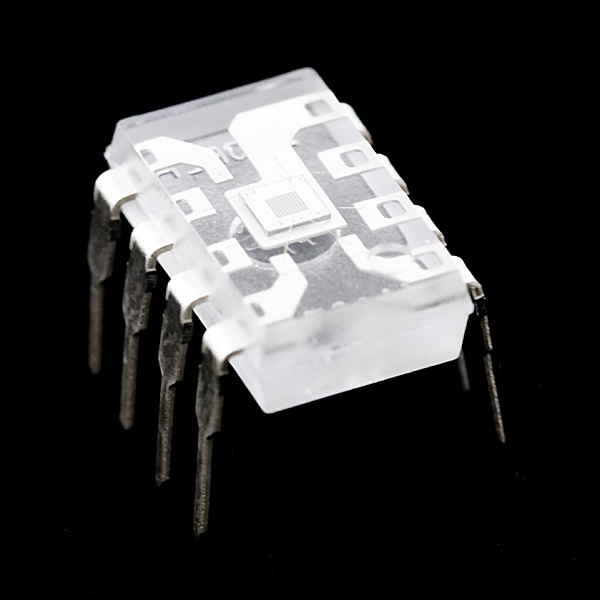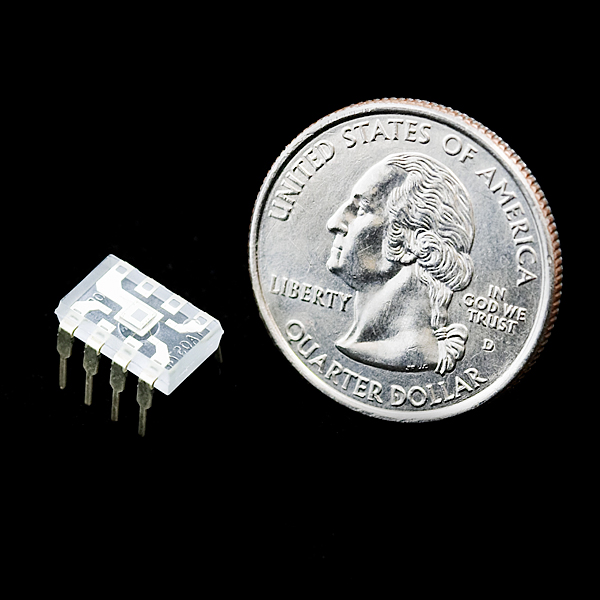Light Intensity to Frequency IC
**Replacement: **None. There is no direct replacement for this sensor but check out the the Light and Imaging category. This page is for reference only.
This is a programmable light to frequency IC from TAOS that outputs a pulse train or a square wave (50% duty) with the frequency that is directly proportional to the incident light intensity. Uses a simple TTL output for easy interfacing to a microcontroller.
Three different sensitivity selections and four different frequency scaling parameters.
- Supply voltage 2.7 - 5.5VDC
- 320nm - 1050nm response range
- 2mA supply current in power on mode
- 5uA current in power down mode mode
- Temperature compensated for UV to visible range
- TSL230R Datasheet
- Great Arduino Tutorial by Roaming Drone
- Bildr Tutorial
Comments
Looking for answers to technical questions?
We welcome your comments and suggestions below. However, if you are looking for solutions to technical questions please see our Technical Assistance page.
Customer Reviews
No reviews yet.





I'm really happy to see these at Spark Fun. I've bought these from Parallax before, and I can vouch for how amazing these chips are. Response time is very fast, and the overall noise is quite low.
I used two of these as servo feedback sensors to build a laser projector out of hard disk voice coils:
http://www.flickr.com/photos/22238428@N05/2932267038/
That laser projector is pretty neat, could you post a build log
I agree. It looks impressive.
second that... very neat for sure
That's the coolest DIP package I've ever seen...
How bout the white 555 timer? Look on mouser... cheapest DIP one they have, I think.
Why removed? '(
hi i need really urgent help this is an amazing chip but i am doing a greenhouse project and would like to know if this chip can be used to tell different light wavelengths pleeeaaaase anyone deadline for the project is in 2 weeks id really appreciate any help
The Taos website shows the SMD version as the replacement. no more DIP package.
I'm thinking of cutting a protoboard into squares, then using jumper wire to connect all of them together except one. Then file down some LEDs 'til they're pointy, solder 'em in, then use this as an awesome buckle, and voila! Electro-gangsta spiky bracelet!
I need to get my results in Lux (unit of illuminance), is this posible with this sensor?
If not, which is the best recomendation for what I am looking for?
Thanks
.Net Micro Framework C# code available here (port of RoamingDrone Arduino C code) -
http://code.tinyclr.com/project/313/taos-tsl230r-light-to-frequency-converter/
How odd. The other day, I put this in the same part box as a magnetic buzzer, and they stuck together. Apparently, the leads on this chip are made out of a ferric metal.
They look so cool!
Really amazing this chip, i created my account just to make this comment; I made the circuit on the Great Arduino tutorial above and used a buzzer with tone() function to give an audio feedback of the frequency, it had been able, in a dark room with all windows closed and just the arduino´s leds as light source, to perceive and give real time feed back of when i was smoking (i.e sucking) the cigar and when i wasn't.
Detail: i did it behind a concrete wall, 4 meters away from the sensor. really AMAZING! it could even detect the shadow cast by my hand on the light of the cigar reflected in the wall!
i just could not filter the fluctuations caused by the power suply, i used the computer usb as power source, and it gave different readings when the comp was plugged on the wall and when it was just on battery.
found a dirty workaround the readings with the wall plug were 60 hz higher, probably for the 60hz frequency of the power line, so i just subtracted it from the frequency.
ok, the last one, the above workaround didn't solved the problem, it seemed ok in the dark, but the readings were completely (hundreds hz)when i put a small light over the sensor.
I cannot see in the documentation a range of operation in reference to lumens/lux. Is this IC suitable for use with HID lamps like metal halide or high pressure sodium?
Old comment, but figured I'd tackle it anyway. The information you need is actually in the datasheet - you're looking for the 'Output Frequency over Irradiance' graph - which happens to be the first one in there.
The problem is in converting from lux to uW (microWatt) / square cm, as that is frequency-dependent. There's an online converter that will do the look-up for 555nm (green), but neither HID nor HP Sodium can be called green ;)
See also:
http://en.wikipedia.org/wiki/Lux#Relationship_between_illuminance_and_irradiance
If you have specific illumination sources, the manufacturer should be able to tell you the correct conversion factor.
Another option, at just a few bucks, is to get this part and just try. If it doesn't work out for what you'd need it, you'll still have a neat clear DIP.. solder to a board and hang it off of your keychain.
I would get it just for that keychain suggestion. Clear IC looks AWESOME!
Hello!
And what's the difference between this version and the originals from Texas Instruments?
Dr. Who: the original had slightly different response curves and specs, otherwise its its a drop-in replacement. Namely the difference is that the TI chip reached an optimal responsivity (1.0) at about 780nm, whereas the Taos chip reaches that responsivity at 640nm. Also note that the Taos chip is more highly sensitive to light in the range of 650-900nm, meaning you have to adjust down for those wavelengths.
Can you specify whether these are the 230R, 230AR, or 230BR? The datasheet references three different models with different tolerance levels.
Thx.
This IC is the TSL230R version.
Excellent - thanks!
I want one! I've never seen a clear IC before...
Good function too.